Streamr Review: Platform For Real Time Data Exchange

Streamr is a fully decentralized and scalable protocol known as a decentralized real-time data network. It empowers users to effortlessly publish and subscribe to data in real-time. The Streamr Network, a peer-to-peer network, facilitates this seamless exchange of data in real-time. It serves as a platform for decentralized messaging, enabling the sharing of data across various applications and broadcasting real-time state changes to large audiences.
Streamr (DATAcoin) is an interesting blockchain project that is developing a marketplace for the real time exchange of data.
Streamr completed an ICO back in the 2017 bull run and managed to secure a great deal of funding. The team has been progressing in the development of the protocol and have partnered with a number of other projects and companies.
However, can Streamr really deliver on their same goals?
In this review of Streamr, I will take a deep dive into their growth prospects. I will also analyse the use cases and long term adoption potential of their DATAcoin.
The Need for Streamr
In a world that is becoming increasingly data driven, access to real-time data is of vital importance for tech companies looking to establish dominance in their field.
Today, data is being generated from all kinds of unique sources, including sensors and connected devices in manufacturing, the service sector, and supply chains.
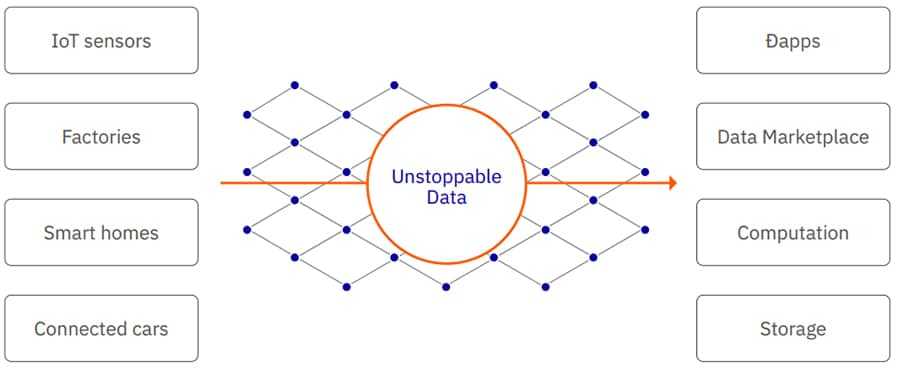
At the same time, we’re seeing the emergence of Dapps in the blockchain space, which increasingly need to rely on distributed data sources from the outside world to fine tune smart contracts and enable more powerful applications to be developed.
From this problem, Streamr has developed a solution; a market for the exchange of real-time data, where anyone can publish events to data streams, subscribe to streams and use the data in decentralized apps.
This real time data is tokenized and traded by users and machines through Streamr’s decentralized P2P network.
Streamr is often compared to IOTA, a cryptocurrency technology that facilitates transactions between IoT (internet of things) devices. We explore some other features that make Streamr different and possibly better than IOTA and its other competitors.
Streamr Use Case
The clearest example of a use case for Streamr is with self driving electric cars. These vehicles rely on all sorts of data to improve their efficiency, including traffic congestion, electricity prices and weather forecasts.
Streamr can help electric cars recieve all of this data in real time. The data would be exchanged for DATACoins, the main currency used on the Streamr network. Afterwords, the car can then sell the data it has acquired to other systems to improve their efficiency as well.
Streamr Technology Stack
Streamr’s decentralized real-time data system is built on top of a technology stack with 5 layers. Below is a visual representation of this technology stack:
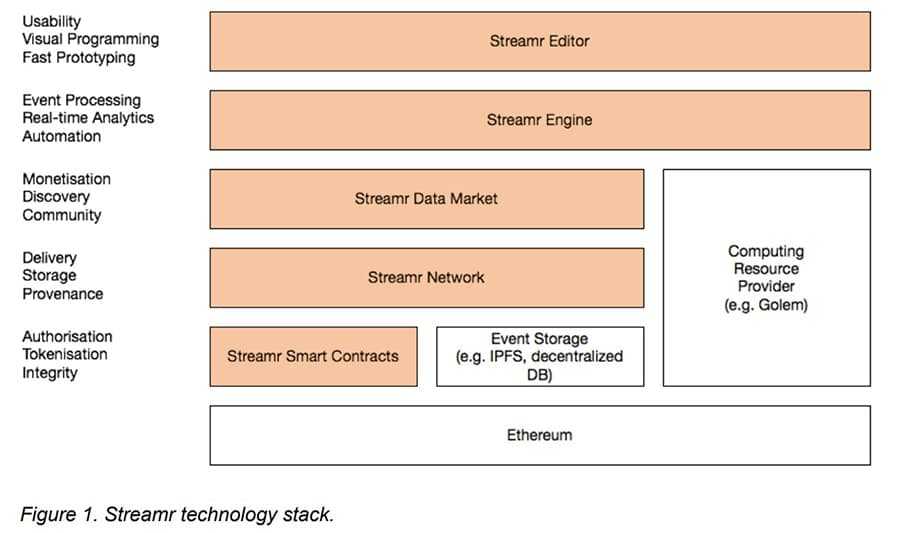
Let's take a deeper look into what each of these technology layers mean
- Streamr Editor: This is a usability layer and toolkit which enables rapid development of decentralized, data-driven apps.
- Streamr Engine: A high performance event processing analytics engine that executes off-chain in a decentralized manner. Streamr engine is capable of running on a decentralized computing provider like Golem (GNT).
- Streamr Data Market: A network of shared data streams that anyone can contribute and subscribe to.
- Streamr Network: The data transport layer that offers a incentive driven peer-to-peer network for messaging in the decentralized data pipeline.
- Streamr Smart Contracts: Allow nodes in the Streamr network to reach consensus, hold stream metadata, handle permissioning and integrity checking, and facilitate secure token transfers.
The DATA Coin
Data coin is an ERC20 token that is used to exchange data between consumers and producers on the Streamr network. It also serves as incentive tool for broker nodes to run in the P2P network.
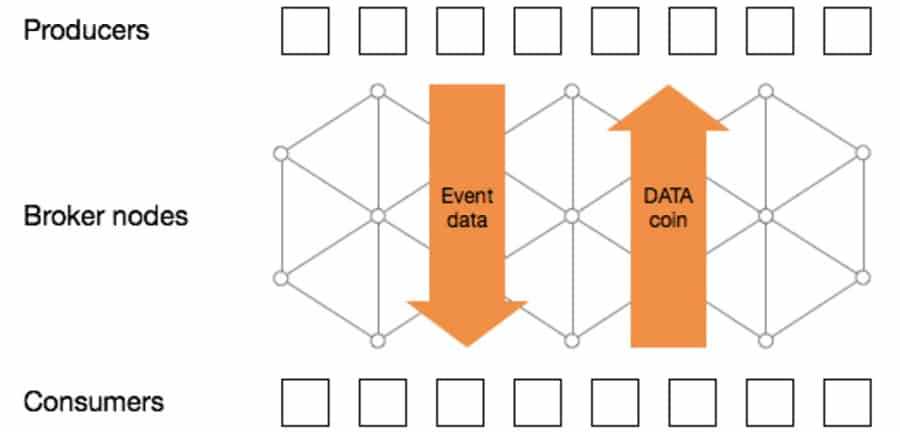
Data Coin has 3 primary use cases:
- To maintain and operate a P2P network by incentivizing participants to offer time, electricity, computing power, and communication bandwidth in order to broker nodes.
- DATAcoin functions as a currency used by consumers to compensate data producers. It also acts as a tool to incentivize data vendors to grow the community.
- DATAcoin serves as a means for measuring reputation through ‘karma’. Data producers, data consumers, and message brokers can gain ‘karma’ from DATA Coin transactions, such as when Publishing data, consuming data and running broker nodes that operate the network. Data producers gain karma when their published events are delivered to subscribers. Subscribers earn karma by receiving these events, and Broker nodes earn karma for helping deliver data and through persistence.New Karma added is equivalent to the amount of DATA Coins exchanged in a transaction. However, unlike DATA coins, karma decays and has an expiration date, while the users balance of DATA coins remains the same throughout.
Streamr vs. IOTA
The biggest difference between IOTA and Streamr is their blockchain: IOTA developed their own DAG Network while Streamr chose to build their network on top of the Ethereum blockchain.
This comes with some advantages, as Streamr is able to take advantage of a much larger developer community who can offer support when needed. They have also been able to save significant resources by not having to build an entirely new infrastructure.

This has allowed them to focus more time and energy on fine tuning their platform and building additional features.
Streamr also has an edge over IOTA because they chose to focus solely on live data, whereas IOTA stores massive amounts of data from IOT devices, which can have an impact on the operating system even when it is decentralized.
Streamr Team & Partners
Streamr Labs has their head office in the Swiss town of Zug. This lies in the middle of "Crypto valley" which is the region in Switzerland that has the most favorable laws / regulation related to blockchain based businesses.

The team has a diverse group of members with experience ranging from machine learning to finance and software development. They also have an eclectic mix of entrepreneurs who have founded and sold other related businesses.
- Henri Pihkala (Founder, CEO): Henri is the CEO and CTO at two algorithmic trading companies. He has also sent 10 years building infrastructure & tools for real-time data.
- Nikke Nylund (Founder): The Streamr co-founder, Nikke has an entrepreneriul background with successful exits in three other companies.
- Risto Karjalainen (COO): Risto has worked as Quant in Investment Banks including JP Morgan Chase and Merrill Lynch. He also has a PHD from the Wharton School of business and is well versed in machine learning and behavioural finance.
- Michael Malka (Head of Streamer Labs ): Michael has spend 20 years in the software industry in several roles, including developer, specialist and CEO. Michael has previously co-founded 3 companies in Blockchain and Artificial Intelligence space.
Streamr has also partnered with a number of other influential projects in the blockchain space. For example, apart from their co-operation with Golem, they have also partnered with Electrify Asia to give users control over their data.

These collaborations also extend to more established companies looking to enter the blockchain space. For example, they are partnering with Hewlett Packard to monetize car data as well as with Nokia to develop the next generation of mobile base stations.
Trading and Storing DATA
Streamr sold these tokens in a much publicized ICO back in October of 2017. They managed to raise a total of $27m in exchange for 65% of the total DATA supply. This saw investors buy into the token at a price of 0.055 USD.
The token hit the exchanges back in November of 2017 and caught the massive rally in altcoins that followed. DATA managed to reach an all time high of $0.31 in January of 2018.
Of course, this was short lived.
Like most altcoins, DATA Coin saw its price drop significantly in 2018. The price is well below that of the ICO but seems to have leveled off. Things appear to be perking up and has been rising slowly with the rest of the market in the first few months of 2019.
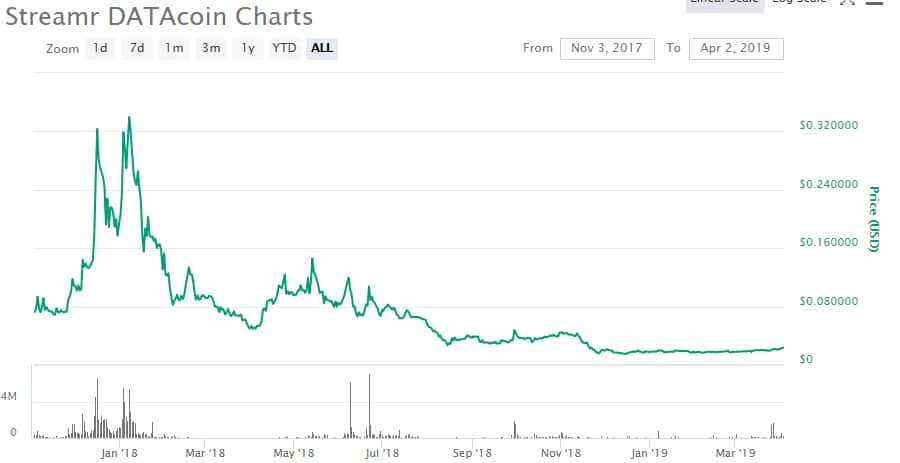
If you are looking to buy DATA coins, then you the best exchange to do this will be on Binance as this has the bulk of the volume. It is also being traded on the DragonEX exchange and a number of other smaller exchanges.
Trading volume in DATA appears to be quite strong with reasonable levels of liquidity on the exchanges that it is listed. However, the token does remain quite volatile when compared to similar sized altcoins.
Once you have got your DATA, you should store it in a secure place as leaving it on an exchange can be quite risky. Given that this is an ERC20 token, there are a range of wallets that you can use. These include the likes of MetaMask and MyEtherWallet.
Development
Getting an exact sense of how much work is being done on a project can be challenging but there are a few useful methods. One of these is by taking a look at their public GitHub and the amount of code being pushed.
I decided to head on over to the Streamr project GitHub and take stock of the code commits to their repositories. Below we have the commits for the 2 most active repos on the project.
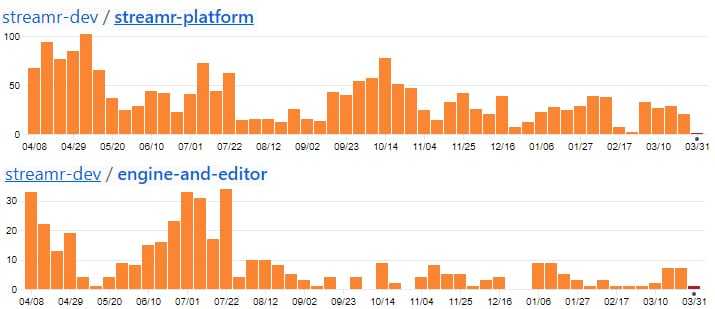
As you can see, the team has been quite active over the past 12 months and are pushing numerous lines of codes to these repos. This is also only two of their repos when they have a total of 40 other ones they have worked on.
Indeed, if we were to compare the number of code commits at Streamr to other coins, they come in at rank 48 on coincodecap. This is with over 3,658 commits in the past year.
This development may be as a result of the ambitious roadmap that the team has ahead of them.
Roadmap
Streamr’s roadmap is divided into 3 milestones (M1,M2, M3)
- Milestone 1: Release the first version of the incentivised data delivery network and the underlying smart contracts. Working on other layers to build towards full integration with the Ethereum ecosystem
- WP1 (Network, Smart Contracts): Prototype decentralized broker network
- WP2 (Marketplace): Barebones marketplace
- WP3 (Engine): Engine goes Ethereum
- WP4 (Editor): Seamless on-chain and off-chain computing
- Milestone 2: Launching the first version of the Data Marketplace, along with the features it needs in the underlying Network layer.
- WP5 (Network, Smart Contracts): Support for data monetization and encryption
- WP6 (Data Market): Completely decentralized Marketplace
- WP7 (Engine, Editor): Achieving decentralization
- Milestone 3: Reach the full Streamr vision: drive adoption of stack
- WP8 (Network): Advanced routing, location obfuscation
- WP9 (Data Market): Community building
- WP10 (Engine, Editor): Productization
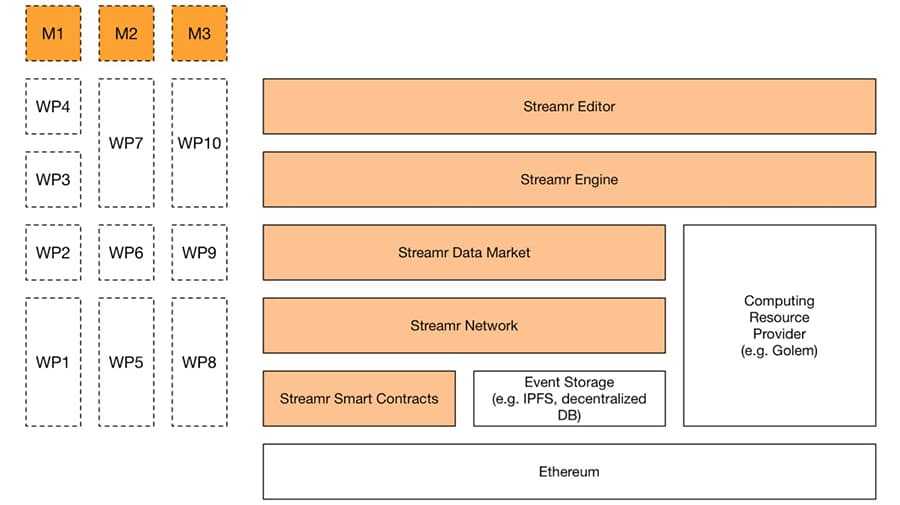
The team has kept this roadmap rather open and have not placed arbitrary timelines to these updates. So, perhaps this is a means for them to manage the expectations of their community.
Conclusion
Since its inception in 2017, Streamr has built a reputation as a worthy addition to the exclusive club of blockchain enabled IOT platforms.
It’s adoption of the Ethereum blockchain means that in many ways, Streamr’s success is tied to the success of Ethereum. This can either be considered an advantage or disadvantage depending on one's view of how the ethereum blockchain functions.
However, what cannot be denied is the value that is being unlocked by creating a marketplace for real time data to be exploited for the purpose of creating more efficiency for sensors and connected devices in manufacturing, the service sector, and supply chains.
The global IOT market is projected to reach $75billion by 2025, putting Streamr in a unique position to enhance this industry through the use of real time data on the blockchain.
Disclaimer: These are the writer’s opinions and should not be considered investment advice. Readers should do their own research.
